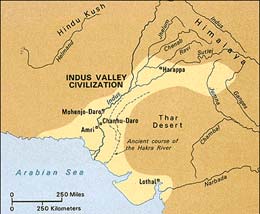

 |  |
 At the stroke of the midnight hour, when the world slept, India awoke to life and freedom on 15th August 1947. On that day, India emerged as an Independent Nation, a nation proud of its ancient culture and civilization. People believed that Indian civilization began with the advent of Aryans. But the discovery of the Indus Valley Civilization proved that a highly developed urban civilization flourished in India much before the arrival of the Aryans.
At the stroke of the midnight hour, when the world slept, India awoke to life and freedom on 15th August 1947. On that day, India emerged as an Independent Nation, a nation proud of its ancient culture and civilization. People believed that Indian civilization began with the advent of Aryans. But the discovery of the Indus Valley Civilization proved that a highly developed urban civilization flourished in India much before the arrival of the Aryans.As early as 1826, Harappa, located in West Punjab (now in Pakistan), attracted the attention of archaeologists. General Cunningham, a British Officer in India, gets credit for preliminary investigation in Harappa. He had visited the place many times and published a report on the Harappa's pictographic unicorn seal in 1875 in the Archaeological Survey of India. Later on, the two officers of the Archaeological Survey of India, Mr. R.D. Banerjee and Mr. R.B. Daya Ram Sahni, carried on excavations in the Larkana district of Sindh province and the Montgomery district of the Punjab. Mr. Sahni discovered the ruins of Harappa in 1921. Mr. Banerjee dug out the ruins of the pre-historic city of Mohen-jo-Daro in 1922. The ruins in these two cities showed that a rich civilization flourished in the country about 3,000 B.C. As the sites of the excavations were situated along the valley of the river Indus and its tributaries, historians named it 'the Indus Valley Civilization'. It was also called the Harappan culture as the first site of this civilization was discovered in Harappa. The Harappan culture was a landmark in the history of man's struggle towards a better civilization. It has proved that some five thousand years ago, highly civilized people lived in the region. "The Indus Valley people gave to the world its earliest cities, its first town planning, its first architecture in stone and clay, its first example of sanitary engineering and drainage system." - Radhakamal Mukherjee. next page >> |
Copyright ©2000 indiansaga.info. All rights reserved.
By using this service, you accept that you won't copy or use the data given in this website for any commercial purpose.
The material on indiansaga.info is for informational & educational purpose only.
This site is best viewed at 800 X 600 picture resolution.